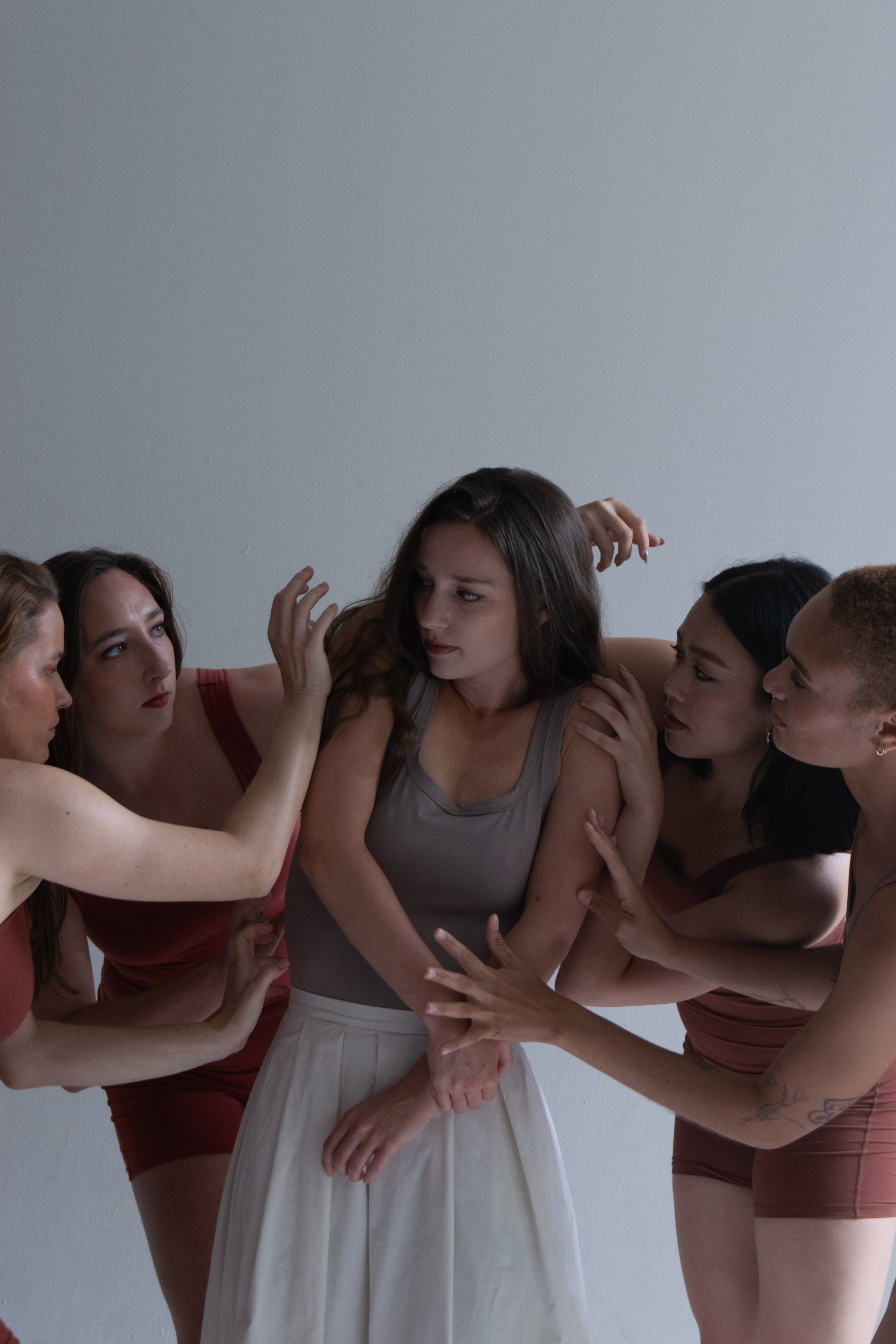La Tarantella
World Premiere at the Brooklyn Art Haus
September 6-7, 2024
Choreographer and Director Michaella Barron
Composer Quinton Nennig
Performers Gabrielle DiNizo, Maddy Hall, Abby Nguyen, Micah McKee, Araya Morris
Music Notes by Quinton Nennig
-
ACT ONE
Tarantella captures the rhythmic vitality of traditional Italian folk music through its lively quarter-eighth note patterns. Composed in the keys of A and E—reflecting the vowels in "tarantella"—the piece navigates through energetic rhythms and bright harmonic changes, embodying the dance’s traditional spirit. The middle section slows down dramatically and introduces the E minor "spider theme," for the first time representing a dramatic shift where one woman is bitten by a spider. This piece is both a celebration of traditional tarantella music and an exploration of thematic contrast.
Giardino evokes the serene and tranquil atmosphere of an Italian garden, where the music unfolds with a soothing and relaxed tone. Unlike traditional classical harmonies, this piece employs chords more commonly associated with jazz, including major 7ths, added 9ths, and 11ths, creating a lush, inviting soundscape that offers the melody and dancers a sense of freedom and ease. A notable feature is the sequence of descending fifths, which grounds the harmony amidst its extended tones. This progression ensures stability and balance while introducing friendly dissonances that subtly suggest underlying distress in one of the dancers.
Mosaica is a musical journey that delves into five distinct feminine archetypes, each brought to life through a unique solo performance. The "Wise Woman" is portrayed through a graceful waltz, exuding both wisdom and elegance. The "Maiden" solo captures the essence of youthful innocence, while the "Wild Woman" injects raw, untamed energy inspired by Czerny. The "Mystic" explores themes of inner peace and self-awareness, and the "Nurturer" embodies a profound sense of compassionate care. However, one solo defies expectations: what should be in C Major shifts to the unsettling Octatonic scale, subtly hinting at underlying discord in one of the dancers. These solos are interspersed between a sarcastic interlude, humorously tying together the diverse elements and creating a cohesive mosaic of feminine identities and individual expression.
Angoscia serves as a haunting prelude to the chaos of Act Two, capturing the sense of impending turmoil through its relentless spinning sixteenth note motif mirroring the delusion, dizziness, and confusion experienced by the dancers. The composition is structured in a rondo form, with themes repeating in various orders to heighten the disorientation and feeling of being lost. Coupled with dark, sequential harmonies in D minor, the music evokes a growing sense of despair and psychological strain. As each woman is metaphorically picked off one by one, the piece effectively conveys their descent into insanity, setting the stage for the dramatic developments of Act Two.
-
ACT TWO
La Malmignatta, named after the Mediterranean black widow, opens the second act with an evocative scurrying motif of eight notes, followed by dark, foreboding chords punctuated by a single note repeated eight times. These recurring patterns of eight symbolize the spider's eight legs and the creature's ominous presence. The piece is also composed entirely in the octatonic [0,1] scale, which divides the octave into eight notes with alternating half and whole steps: C, C#, D#, E, F#, G, A, and Bb. This scale creates a haunting, dissonant atmosphere, reinforcing the spider’s menacing influence while weaving a web of tension and unease throughout the entire piece.
Diapause delves into the theme of suspended development in arachnids, akin to hibernation, through a hypnotic and trance-like musical landscape. The piece opens with a subtle, melodic void, featuring repetitive notes that evoke a sense of stillness. As it progresses, a sense of awakening gradually unfolds, with a developing melody emerging over the unusual harmonic shifts. A tantalizing descending pattern assures the transition from stasis to mobility. The composition offers an auditory journey from profound stillness to vibrant melodic emergence, reflecting the slow yet transformative process of awakening.
Arachnidism delves into the complex interplay between fear and allure associated with spiders, transforming this unsettling concept into a captivating musical narrative. Although the term "arachnidism," which refers to a spider bite, may evoke anxiety, the music itself is surprisingly inviting, unfolding as a tender love duet. It begins with an eight note ascending and descending pattern, which symbolizes the spider and a melody underneath symbolizing the woman who gradually becomes entangled in the spider’s charm. The interaction between the right and left hands represents the growing manipulation and eventual enamoration of the woman with the spider. As the piece progresses, it takes a darker turn with a reprise of the E minor spider theme from the earlier Tarantella, underscoring the transformation from initial allure to complete deception.
Ecdysis, named after the process of molting an exoskeleton, symbolizes profound transformation and change. The music is dark and chromatic, mirroring the evolution of the dancers throughout the show. Each dancer’s theme is revisited in a minor key, reflecting the deepening despair and psychological turmoil they experience. The piece culminates in a somber funeral march, marking the inevitable descent into their doom as the second act concludes. This piece conveys the journey from transformation to resignation, encapsulating the darkness of the characters' final moments.
-
ACT THREE
Cascata, meaning waterfall, draws inspiration from the structure of a passacaglia, utilizing a repeated chord progression with evolving textures. The piece is imbued with imagery of cascading water, beginning with gentle, downward sweeping arpeggios that symbolize the awakening of the dancers. As the music progresses, these arpeggios grow in intensity, expanding into rich, vibrant textures that mirror the dancers' growing awareness and transformation. Melodies begin to form, reflecting their deeper connection to their new selves until the piece concludes with a reprise of Giardino, signifying that Cascata has effectively ‘washed the spider out,’ cleansing the previous turmoil with its revitalizing flow.
Rinascita, or rebirth, opens with a powerful assertion of newfound freedom, immediately establishing a sense of liberation. Each dancer’s theme is resurrected in succession, accompanied by a continuous, unifying pattern that symbolizes collective strength. As the piece progresses, these solos build towards a climactic moment where one of the dancers finally takes center stage to perform her long-awaited solo, originally intended for Mosaica that was harmonically interrupted due to her earlier affliction. This performance highlights the resurgence of feminine power and emphasizes the transformative strength of unity.
Tarantella Rag brings us back to the vibrant spirit of the original tarantella with its traditional, lively rhythms. This familiar dance is then reimagined as a fun, energetic rag, infusing fresh rhythmic vitality. In the middle section, there is a final reprise of the E minor spider theme, but this time it is reimagined in E major, symbolizing newfound hope and liberation. The composition concludes with powerful, slow octaves in a dotted rhythm, symbolizing the dancers' sense of resolution and unified power as the show reaches its finale.
Learn More About The Female Archetypes
-
Deepest desire: Inner peace
Goal: Living a meaningful life
Deepest fear: Feeling disconnected and out of control
-
Deepest desire: freedom on all levels
Goal: to follow her own, often unconventional path
Deepest fear: feeling vulnerable, powerless or trapped
-
Deepest desire: Discovering and sharing truth
Goal: Self-mastery
Deepest fear: Not being recognized for who she is
-
Deepest desire: harmony
Goal: to live a happy life, make the world a better place
Deepest fear: being judged negatively by others, being abandoned
-
Deepest desire: to be of service
Goal: to contribute to other people’s happiness, to help and nurture
Deepest fear: to be met with ingratitude, feeling useless

